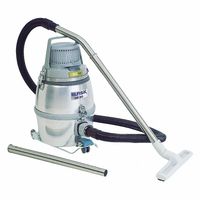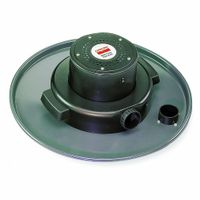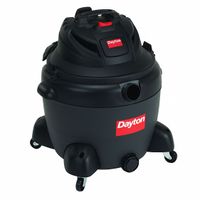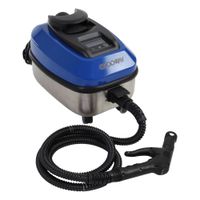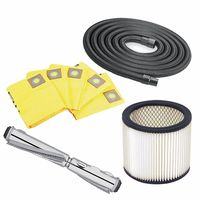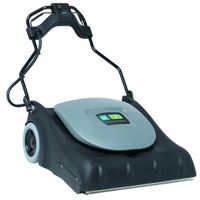Call +(254) 703 030 000 / 751 483 999 / 721 704 777
- Home
- Cleaning And Janitorial
- Floor Cleaning Machines
- Vacuum Cleaners Accessories
.....Read More
Frequently Asked Questions
What are the best vacuum cleaners for commercial use?
The best vacuum cleaners for commercial use are typically robust, efficient, and designed to handle large areas and heavy-duty cleaning tasks. Here are some top options:
1. **ProTeam Super CoachVac**: Known for its powerful suction and large capacity, this backpack vacuum is ideal for cleaning large spaces quickly. It features a HEPA filtration system, making it suitable for environments where air quality is a concern.
2. **Sanitaire SC9180B**: This dual-motor upright vacuum is excellent for commercial settings, offering strong suction and a wide cleaning path. It includes a sealed HEPA filtration system and is designed for durability and ease of maintenance.
3. **Hoover Commercial HushTone CH54115**: This upright vacuum is designed for quiet operation, making it suitable for environments where noise is a concern. It features a HEPA filtration system and a large capacity bag, ensuring efficient cleaning.
4. **Nilfisk GD930**: Known for its durability and powerful suction, this canister vacuum is ideal for large commercial spaces. It features a multi-stage filtration system and a large dust bag capacity, making it efficient for extended use.
5. **Oreck Commercial XL2100RHS**: This lightweight upright vacuum is easy to maneuver and is designed for high-traffic areas. It features a powerful motor and a wide cleaning path, making it efficient for quick cleanups.
6. **Bissell BigGreen Commercial BG10**: This deep-cleaning carpet extractor is perfect for commercial spaces with carpeted areas. It offers powerful suction and a large tank capacity, ensuring thorough cleaning.
These vacuum cleaners are selected based on their performance, durability, and suitability for various commercial environments, ensuring efficient and effective cleaning.
How do wet/dry vacuums differ from regular vacuums?
Wet/dry vacuums, also known as shop vacs, differ from regular vacuums in several key ways:
1. **Functionality**: Wet/dry vacuums are designed to handle both liquid spills and dry debris, whereas regular vacuums are typically limited to dry materials. This makes wet/dry vacuums versatile for various cleaning tasks, including cleaning up water spills, wet messes, and even some hazardous materials.
2. **Construction**: Wet/dry vacuums are built with more robust and durable materials to withstand the rigors of handling liquids and heavy debris. They often have a larger, more powerful motor to accommodate the increased demands of wet and dry cleaning.
3. **Filtration System**: Wet/dry vacuums usually have a different filtration system that can handle moisture without getting damaged. They often include a foam filter for wet pick-up and a cartridge or paper filter for dry debris. Regular vacuums typically have filters designed only for dry materials.
4. **Tank Design**: The tanks in wet/dry vacuums are often larger and made of materials like stainless steel or heavy-duty plastic to prevent rust and corrosion from moisture. They are also designed to be easily emptied and cleaned.
5. **Attachments and Accessories**: Wet/dry vacuums come with a variety of attachments specifically for wet and dry cleaning, such as squeegee tools for liquid spills and wide nozzles for large debris. Regular vacuums usually have attachments focused on dry cleaning, like brushes and crevice tools.
6. **Portability and Size**: Wet/dry vacuums are generally bulkier and heavier due to their larger motors and tanks. They often have wheels and handles for easier mobility, especially in workshop or construction settings.
7. **Applications**: Wet/dry vacuums are commonly used in workshops, garages, and construction sites, while regular vacuums are more suited for household cleaning tasks.
What features should I look for in a commercial upright vacuum?
When selecting a commercial upright vacuum, consider the following features:
1. **Suction Power**: Look for a vacuum with strong suction to effectively clean various surfaces, including carpets and hard floors.
2. **Durability**: Choose a model made from high-quality materials to withstand frequent use in commercial settings.
3. **Filtration System**: Opt for a vacuum with a HEPA filter to trap allergens and improve air quality, especially important in environments like hospitals or schools.
4. **Capacity**: A larger dustbin or bag capacity reduces the frequency of emptying, which is beneficial in large areas.
5. **Weight and Maneuverability**: A lightweight design with swivel steering makes it easier to navigate around furniture and tight spaces.
6. **Cord Length**: A longer power cord allows for greater reach without needing to switch outlets frequently.
7. **Noise Level**: Consider a vacuum with a lower decibel rating to minimize disruption in noise-sensitive environments.
8. **Attachments and Accessories**: Look for models that include tools like crevice tools, upholstery brushes, and extension wands for versatile cleaning.
9. **Height Adjustment**: Adjustable height settings ensure optimal performance on different floor types.
10. **Ease of Maintenance**: Features like easy-to-change bags or filters and accessible brush rolls simplify maintenance.
11. **Warranty and Support**: A good warranty and reliable customer support can provide peace of mind and assistance if issues arise.
12. **Energy Efficiency**: Energy-efficient models can reduce operational costs over time.
13. **Brand Reputation**: Consider brands known for reliability and quality in commercial cleaning equipment.
14. **Price**: Balance your budget with the features and durability required for your specific cleaning needs.
How do backpack vacuums improve cleaning efficiency?
Backpack vacuums enhance cleaning efficiency through several key features. Firstly, their ergonomic design allows for greater mobility and ease of use. By wearing the vacuum on the back, users can move freely without dragging a canister or upright vacuum, making it easier to navigate around furniture and tight spaces. This design reduces physical strain and fatigue, enabling longer cleaning sessions without discomfort.
Secondly, backpack vacuums often come with powerful suction capabilities and high-efficiency filtration systems. These features ensure that dust, dirt, and allergens are effectively captured, improving indoor air quality and reducing the need for repeated cleaning. The high-capacity bags or canisters in backpack vacuums also mean less frequent emptying, saving time during cleaning tasks.
Additionally, the versatile attachments and tools that come with backpack vacuums allow for cleaning a variety of surfaces, from carpets and hard floors to upholstery and drapes. This adaptability means that a single device can handle multiple cleaning tasks, streamlining the process and reducing the need for multiple cleaning tools.
Moreover, the lightweight nature of backpack vacuums makes them ideal for cleaning large areas, such as commercial spaces or multi-story buildings. The ability to cover more ground quickly without the hassle of plugging and unplugging a cord in different outlets further enhances efficiency.
Finally, the quiet operation of many backpack vacuums allows for cleaning in noise-sensitive environments, such as offices or schools, without causing disruption. This feature enables cleaning during business hours, maximizing productivity and minimizing downtime.
In summary, backpack vacuums improve cleaning efficiency through enhanced mobility, powerful suction, versatile attachments, lightweight design, and quiet operation, making them a preferred choice for both residential and commercial cleaning tasks.
What are critical-area vacuums used for?
Critical-area vacuums are specialized cleaning devices designed for environments that require stringent contamination control. These vacuums are primarily used in cleanrooms, laboratories, pharmaceutical manufacturing facilities, semiconductor fabrication plants, and other controlled environments where maintaining a high level of cleanliness is crucial.
The primary purpose of critical-area vacuums is to remove particulate matter, dust, and other contaminants that could compromise the integrity of sensitive processes or products. They are engineered to meet specific standards, such as HEPA (High-Efficiency Particulate Air) or ULPA (Ultra-Low Penetration Air) filtration, which ensures that even the smallest particles are effectively captured and not reintroduced into the environment.
In cleanrooms, critical-area vacuums help maintain the required cleanliness class by preventing the accumulation of particles that could interfere with the production of microelectronics, pharmaceuticals, or other precision products. In laboratories, they are used to clean up hazardous materials or biological contaminants safely, ensuring the safety of personnel and the integrity of experiments.
These vacuums are often constructed from materials that do not shed particles or outgas, further minimizing the risk of contamination. They may also be designed to be easily sterilized or decontaminated, allowing them to be used in sterile environments without introducing new contaminants.
Overall, critical-area vacuums are essential tools in any setting where contamination control is a priority, helping to ensure product quality, process integrity, and compliance with industry standards and regulations.
How do I choose the right vacuum accessories for specific cleaning tasks?
To choose the right vacuum accessories for specific cleaning tasks, consider the following:
1. **Surface Type**:
- **Carpets and Rugs**: Use a motorized brush or powerhead to agitate fibers and remove embedded dirt.
- **Hard Floors**: Opt for a hard floor tool or a soft-bristle brush to prevent scratching.
- **Delicate Surfaces**: Use a dusting brush with soft bristles for gentle cleaning.
2. **Cleaning Task**:
- **Pet Hair**: A pet hair tool or turbo brush is effective for removing hair from upholstery and carpets.
- **Crevices and Corners**: A crevice tool is ideal for tight spaces and corners.
- **Upholstery**: An upholstery tool with fabric strips or a small brush is suitable for furniture and drapes.
- **Stairs**: A stair tool, often smaller and angled, helps clean staircases efficiently.
3. **Special Needs**:
- **Allergens**: Use a HEPA filter attachment to capture fine dust and allergens.
- **Wet/Dry Cleaning**: Ensure compatibility with wet/dry vacuums for liquid spills.
4. **Vacuum Compatibility**:
- Check the model and brand compatibility to ensure the accessory fits your vacuum.
5. **Frequency of Use**:
- Invest in durable, high-quality tools for frequently performed tasks.
6. **Storage and Maintenance**:
- Consider the ease of storage and cleaning of the accessory.
By assessing these factors, you can select the most effective vacuum accessories for your specific cleaning needs, ensuring efficient and thorough cleaning.
What maintenance is required to keep vacuum cleaners in optimal condition?
To keep vacuum cleaners in optimal condition, regular maintenance is essential. Start by emptying the dust bag or canister frequently to prevent clogs and maintain suction power. For bagless models, wash the canister with warm, soapy water and ensure it is completely dry before reassembly.
Check and clean or replace filters as per the manufacturer's instructions. HEPA filters, in particular, need regular attention to maintain air quality and performance. Clean the brush roll by removing hair, threads, and debris that can wrap around it, which can hinder its rotation and effectiveness.
Inspect the vacuum's hoses and attachments for blockages. Use a long, flexible brush or a straightened coat hanger to clear any obstructions. Examine the vacuum belt for wear and tear; replace it if it appears stretched or damaged to ensure the brush roll spins correctly.
Regularly wipe down the vacuum's exterior with a damp cloth to remove dust and dirt. Lubricate any moving parts, such as wheels or hinges, with a light machine oil if recommended by the manufacturer.
Check the power cord for any signs of damage or fraying, and ensure it is stored properly to prevent kinks or breaks. If the vacuum has a retractable cord, avoid pulling it out completely to prevent stress on the mechanism.
Finally, schedule professional servicing if the vacuum exhibits persistent issues like loss of suction, unusual noises, or overheating. Regular maintenance not only extends the life of the vacuum cleaner but also ensures it operates efficiently, providing optimal cleaning performance.


